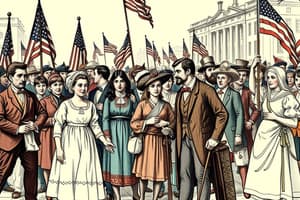Podcast
Questions and Answers
What was the central component of the early 20th century American colonial regime in the Philippines?
What was the central component of the early 20th century American colonial regime in the Philippines?
- Deliberate attempt to Americanize (correct)
- Development of native art forms
- Promotion of indigenous languages
- Expansion of local governance
Which artwork by Fernando Amorsolo emphasizes the role of women?
Which artwork by Fernando Amorsolo emphasizes the role of women?
- Madonna of the Slums
- Bituing Marikit
- The Palay Maiden (correct)
- The Sketch
Who was primarily recognized for their contributions to the documentation of Philippine folk dances?
Who was primarily recognized for their contributions to the documentation of Philippine folk dances?
- Victorio Edades
- Francisca Reyes Aquino (correct)
- Nicanor Abelardo
- Kenkoy
Which period followed the American colonial regime and was characterized by a sense of nostalgia due to wartime losses?
Which period followed the American colonial regime and was characterized by a sense of nostalgia due to wartime losses?
What type of art emerged from the transformation of military jeeps into colorful transportation?
What type of art emerged from the transformation of military jeeps into colorful transportation?
What does the artwork 'Madonna of the Slums' primarily represent?
What does the artwork 'Madonna of the Slums' primarily represent?
Which artist's work is seen as a bridge between Filipino and American art?
Which artist's work is seen as a bridge between Filipino and American art?
What was the function of the artwork 'Malakas at Si Maganda' during President Marcos's regime?
What was the function of the artwork 'Malakas at Si Maganda' during President Marcos's regime?
Flashcards are hidden until you start studying
Study Notes
Americanization
- Americanization significantly influenced Philippine culture during the early 20th century.
- The Philippine Normal School, established in 1901, was a key institution in this process, implementing educational reforms.
- The Bureau of Public Works oversaw infrastructure projects, shaping the modern Filipino landscape.
- The Americanization efforts aimed to modernize the Filipino lifestyle and economy, establishing a dependence on the United States.
- Filipino art reflected the cultural shift, with artists like Fernando Amorsolo and Nicanor Abelardo incorporating American influences into their works.
- Victorio Edades, who studied architecture in the US, bridged Filipino and American art styles in his work.
- Folk dances were recognized and preserved through the efforts of Francisca Reyes Aquino and her colleagues.
- The character Kenkoy, created by Antonio Velasquez, embodied the Americanized Filipino in the late 1920s.
Art in War
- The Japanese occupation during World War II had a profound impact on Philippine art, reflecting the struggles and resilience of the Filipino people.
- Demetrio Diego's "Capas" (1948) commemorated the Filipinos who fought in the war.
- Artworks like "Liwayway ng Kalayaan" (1944) and "Ang Gerilya Kung Orasyon" (1942-1945) captured the wartime experience.
Post-War
- The Philippines experienced a sense of nostalgia for the nation lost during the war.
- Jeepney art emerged, transforming military jeeps into colorful public transportation, symbolic of Filipino creativity and resourcefulness.
- Manuel Conde's film "Orasang Ginto" (1946) depicted the challenges faced by Filipinos as they rebuilt their lives after the war.
Modernism
- A modern art movement challenged the prevailing conservatism in the Philippines.
- Artists began incorporating Western art styles like cubism, abstraction, and expressionism into their works.
- Hernando Ocampo's "Break of the Day" (1948) illustrated the themes of hope and resilience in the post-war period.
- Vicente Manansala's "Madonna of the Slums" (1950) highlighted the poverty faced by Filipinos, using the Madonna figure as a symbol of suffering and resilience.
Martial Law and the Arts of Resistance
- During martial law under President Marcos, art and culture was used as a tool for propaganda and control.
- Evan Cosayo's "Malakas at Si Maganda" (1975) was commissioned by Ferdinand and Imelda Marcos, reflecting the regime's ideology.
- Jaime De Guzman's "Gomburza" (1970) showcased resistance against the Marcos regime, highlighting the struggle for freedom and justice.
Studying That Suits You
Use AI to generate personalized quizzes and flashcards to suit your learning preferences.




